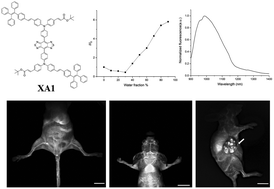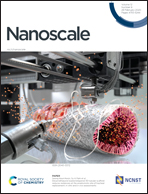Molecular engineering of a high quantum yield NIR-II molecular fluorophore with aggregation-induced emission (AIE) characteristics for in vivo imaging†
Abstract
NIR-II biological imaging (1000–1700 nm) has shown promise for deep tissue penetration, high spatial resolution, and low background noise. Among all the NIR-II probes, organic probes particularly attract huge attention due to their excellent stability and biocompatibility, which have the most potential for clinical translation. However, most previously reported organic NIR-II fluorescent agents often suffer from low quantum yields in aqueous solution. Herein, we developed a novel D–π-A–π-D-type NIR II chromophore XA1 with AIE characteristics based on a new design strategy for NIR-II AIE fluorophores. Owing to their intrinsic aggregation-induced emission enhancement nature, the formulated XA1 NPs show a high fluorescence quantum yield up to 14.8%, which is higher than those of most previously reported organic NIR-II fluorophores. Based on the XA1 NPs, noninvasive imaging of limb and cerebral vessels is achieved with a high signal-to-background ratio and deep penetration. Furthermore, the XA1 NPs can be used as good contrast agents for high resolution imaging of blood vessels of tumors and precise detection of tumors based on the EPR mechanism. Collectively, our work demonstrated a novel strategy for designing and manufacturing NIR-II fluorophores with AIE characteristics and proved that XA1 NPs are highly promising NIR-II probes for biomedical imaging under physiological and pathological conditions.



 Please wait while we load your content...
Please wait while we load your content...